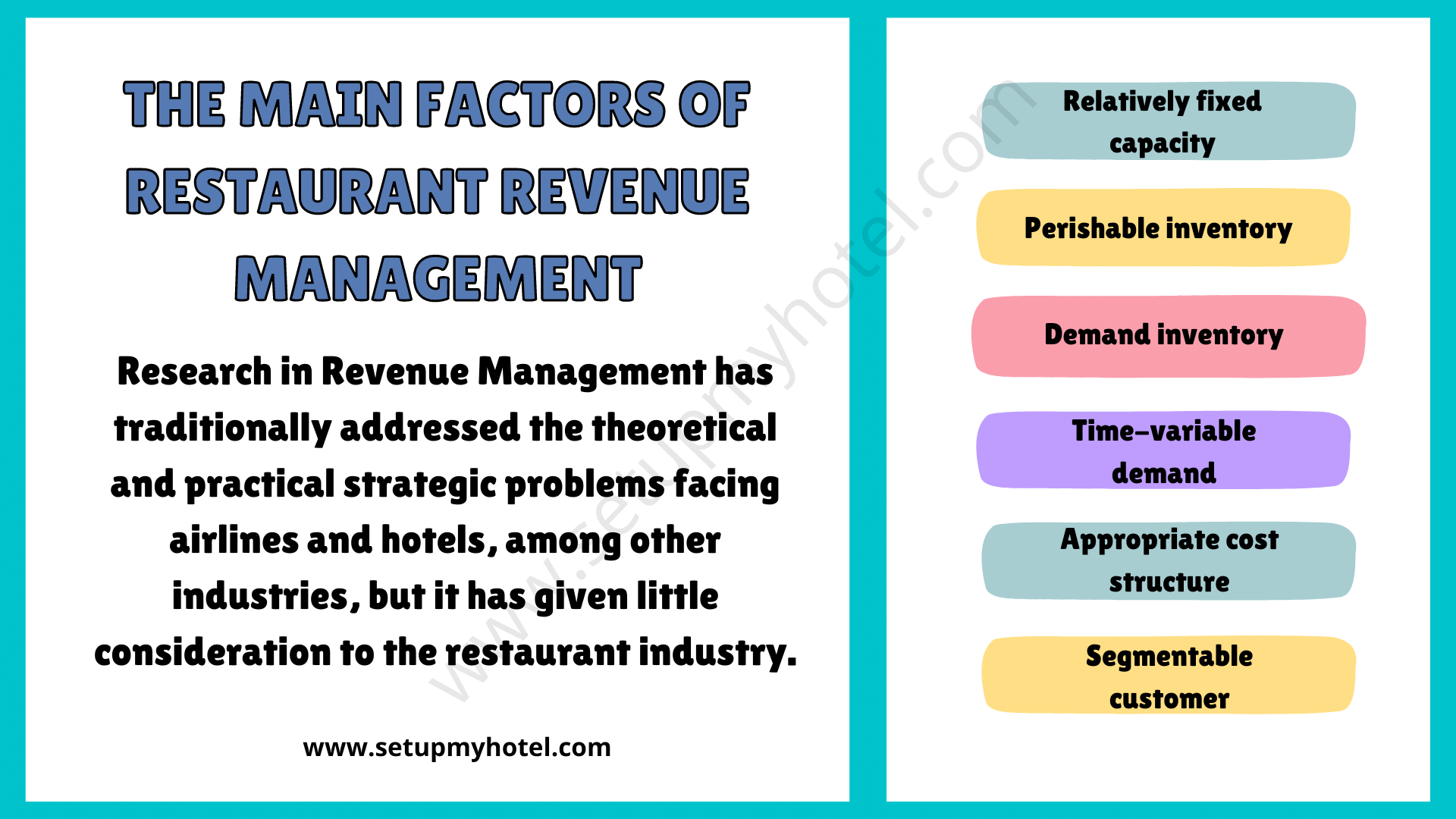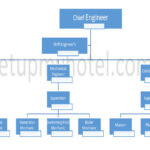The Main Factors Of Restaurant Revenue Management
Restaurant revenue management involves a strategic approach to pricing, marketingA system of interrelated activities formulated to plan; price; promote and make available the servic..., and operations to maximize revenue and profitability. Key factors influencing restaurant revenue management include:
- Pricing Strategies:
- Implement dynamic pricing based on factors such as peak hours, day of the week, seasonality, and special events. Adjust menu prices to optimize revenue during different periods.
- MenuThe list of dishes on offer in a restaurant. those ready prepared are on the table dh6te side; those... Engineering:
- Analyze the popularity and profitability of menu items. Focus on promoting high-margin items and consider adjusting prices or portion sizes for less profitable items.
- Demand ForecastingForecasting means establishing where present courses of action will lead. An activity of planning.:
- Utilize historical data and trends to forecast demand accurately. Anticipate peak periods and allocate resources accordingly to enhance efficiency during busy times.
- Table Turnover Optimization:
- Increase table turnover rates during peak hours by optimizing service speed without compromising quality. Manage reservations efficiently and encourage bookings during busy periods.
- PromotionsPromotions - The ways in which a business tries to persuade people to buy its products and services.... and Specials:
- Design strategic promotions and specials to attract customers during slower periods. Implement happy hours, discounted packages, or limited-time offers to stimulate demand.
- Online ReservationThe department that receives; documents and processes reservation requests. Systems:
- Implement an efficient online reservation system to manage bookings effectively. Encourage customers to book in advance, helping you plan staffing levels and optimize table turnover.
- Customer Relationship Management (CRMCustomer Relationship Management (CRM) Refers to the automation; via sophisticated software; of busi...):
- Utilize CRM systems to collect and analyze customer data. Identify and reward loyal customers, personalize marketing efforts, and encourage repeat business through loyalty programs.
- Staff Training for UpsellingA sales technique whereby a guest is offered a more expensive room than what he or she reserved or o...:
- Train staff to upsell and cross-sell strategically. Encourage suggestive selling of high-margin items and promote special offerings to increase the average check value.
- Adaptive Marketing Strategies:
- Implement marketing strategies that adapt to changing market conditions. Utilize digital marketing channels, social media, and targeted campaigns to attract different customer segments.
- Technology Integration:
- LeverageLeverage is a method of financing whereby more debt (liabilities) is used than equity (owners invest... technology solutions such as point-of-sale (POSPoint-of-Sale (POS) Terminal: A cash register with the capability to scan a UPC code with a laser an...) systems and analytics tools to gather data and insights. Use technology to streamline operations, improve efficiency, and make informed decisions.
- Capacity Management:
- Optimize seating capacity by strategically arranging tables and adjusting reservations during peak hours. BalanceBalance is the amount of an account at a point in time. the desire for a full house with the need for efficient table turnover.
- Feedback and Reviews Management:
- Monitor customer feedback and online reviews. Address concerns promptly, as positive reviews can attract more customers, while negative ones may impact your reputation and revenue.
- Partnerships and Collaborations:
- Collaborate with local businesses or event organizers to host joint promotions or events. This can attract a broader audience and increase foot traffic during specific periods.
- Data AnalysisAnalysis is the assessment of the flow of information and services of a specific property to determi...:
- Regularly analyze financial and operational data to identify trends, opportunities, and areas for improvement. Use data-driven insights to refine strategies and adapt to changing market conditions.
Research in Revenue Management has traditionally addressed the theoretical and practical strategic problems facing airlines and hotels, among other industries, but it has given little consideration to the restaurant industry.
The restaurant business is similar enough to hotel and airline operations that restaurants should be able to apply revenue-management-type practices strategically, but the applications have so far been mostly tactical. A broad theory of revenue management would permit restaurant operators to gain the benefits of strategic revenue management that they currently lack.
How Do define restaurant Revenue Management Factors?
Revenue managementRevenue management� is a flexible pricing policy for rooms that adjusts quickly to supply and dema... is the application of information systems and pricing strategies to allocate the right capacity to the right customer at the right place at the right time. In practice, revenue management has meant determining pricing according to predicted demand levels so that price-sensitive customers can achieve a favourable price by purchasing at off-peak times, while price-insensitive customers will be able to make their purchases at the peak times that they desire.
The application of revenue management has been most effective when it is applied to operations that have the following characteristics: relatively fixed capacity, perishable inventory, a demand inventory, time-variable demand, appropriate cost structure, and segmentable customers.
1. Relatively fixed capacity: A restaurant’s Relatively fixed capacity capacity can be measured by number of seats, kitchen size, menu items, or staffing levels. Most restaurant operators’ approaches to optimizing revenue primarily involve filling the seats and turning tables as quickly as possible, but that effort can be limited by the kitchen, the menu design, or staff members’ capabilities.
Seating capacity is generally fixed over the short term, although restaurants have some flexibility to crowd a table with an additional seat if necessary, and the restaurant’s cost of adding additional capacity in the forms of tables or seats (say, by reconfiguring the dining room or seating diners in the lounge) is lower than that of many businesses that typically use revenue management.
Most restaurants have a fixed number of tables but can vary the number of seats depending on the mix of party sizes. In addition, some restaurants might increase capacity during pleasant weather by using outdoor dining.
2. Perishable inventory: One might think of the Perishable inventory of a restaurant’s inventory as being its supply of raw food, but most of that is not perishable until it is removed from the freezer or is sitting on the receiving dock. Instead, a restaurant’s inventory is best thought of as time or, in this case, the time during which a seat or table is available. If a seat is not occupied for some time, that part of the restaurant’s inventory perishes.
This is the key to the strategic framework that I present here, and it is the element that I believe has been missing in most approaches to restaurant revenue management. Instead of counting table turns or revenue for a given day part, restaurant operators should measure revenue per available seat hour (RevPASH). This measure captures the time factor involved in restaurant seating.
3. Demand inventory: Demand can be Demand inventory inventoried either by taking reservations or by creating queues of waiting guests. Most industries that employ revenue management use reservations (or advance sales) to create a demand inventory. Reservations are valuable because they allow an operator to sell and control his or her inventory in advance of consumption (often with advance payment for that consumption).
In addition, companies that take reservations have the option to accept or reject reservation requests. During high-demand periods, operators may choose to reject low-value requests, for instance, while during low-demand periods, managers may choose to accept such requests.
While many restaurants take reservations, a majority of restaurants do not do so, preferring instead to manage a queue when demand exceeds supply. Indeed, while reservations help a restaurant sell and control its inventory, they are not without problems. As I discussed later, no-shows, late shows, and short-shows are all problems in the restaurant industry, which is why some restaurants choose to rely on walk-in business rather than take reservations.
4. Time-variable demand: Setting aside Time-variable demand carry-out activities as a separate business, restaurant demand consists of guests who make reservations and guests who walk in. Both forms of demand can be managed, albeit with different strategies. Strategic differences notwithstanding, guests who make reservations and those who walk in constitute an inventory from which managers can select the most profitable mix of customers. To do this, however, restaurant operators must forecast customer demand and manage the revenue generated from that demand.
Restaurant demand has two components – namely, the timing of the demand and the duration of that demand (that is, how long the meal lasts). As in most businesses, customer demand varies by time of year, day of week, and time of day. For restaurants, dinner demand may be higher on weekends, during summer months, or at particular times during the lunch or dinner periods. Restaurant operators must be able to forecast time-related demand so that they can make effective pricing and table allocation decisions.
A special factor for restaurant operators is that they have to reckon with the length of time a party stays once it is seated. This factor is analogous to a hotel’s having to forecast the number of guests who will stay an additional night, but the hotel still is selling an integral room-night to the stay-over guest and not dealing with the often unpredictable period that diners will stay at a table. If restaurant managers can accurately predict meal duration, they can make better reservation decisions and give better estimates of waiting times for walk-in guests.
5. Appropriate cost structure: Like hotels, Appropriate cost structure restaurants have a cost structure that features relatively high fixed costs and fairly low variable costs, although it’s true that a menu item’s food-cost percentage is usually higher than the variable-cost percentage associated with a hotel room.
Like hotels, restaurants must generate sufficient revenue from each sale to cover variable costs and offset at least some fixed costs. Nevertheless, restaurants’ relatively low variable costs allow for some pricing flexibility and give operators the option of reducing prices during low-demand times.
6. Segmentable customer: Like hotels, restaurants have some customers who are price-sensitive and others who are not. For example, certain customers (for instance, students, families with small children, or people on fixed incomes) may be willing to change their dining time in exchange for a discounted price.
Conversely, other customers are not at all price-sensitive and are often willing to pay a premium for a desirable table at a desirable time. Restaurant operators need to be able to identify these two segments and design and price services to differentiate them and meet their needs.
By focusing on these factors, restaurant owners and managers can implement effective revenue management strategies, ultimately leading to increased profitability and sustained success.











